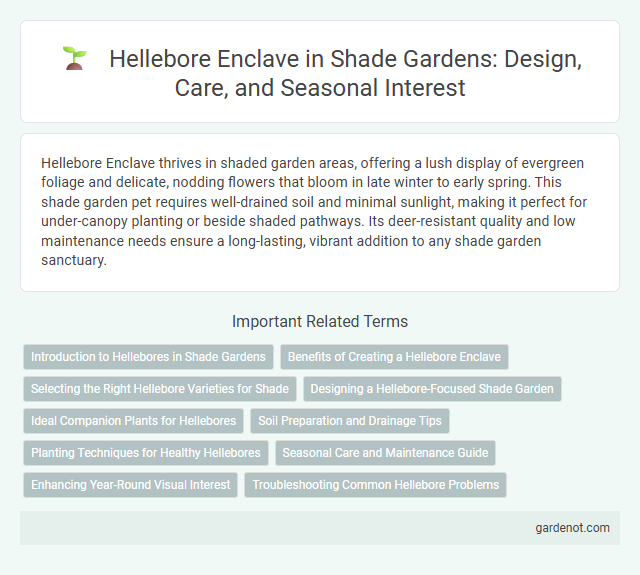Hellebore Enclave thrives in shaded garden areas, offering a lush display of evergreen foliage and delicate, nodding flowers that bloom in late winter to early spring. This shade garden pet requires well-drained soil and minimal sunlight, making it perfect for under-canopy planting or beside shaded pathways. Its deer-resistant quality and low maintenance needs ensure a long-lasting, vibrant addition to any shade garden sanctuary.
Introduction to Hellebores in Shade Gardens
Hellebores, prized for their early spring blooms, thrive in shade gardens, offering vibrant color when few other plants do. These perennial plants prefer well-drained soil enriched with organic matter and dappled sunlight, making them ideal for woodland or shade garden settings. With their evergreen foliage and long-lasting flowers, hellebores create a low-maintenance, year-round interest in shaded garden beds.
Benefits of Creating a Hellebore Enclave
Creating a Hellebore enclave enhances shade gardens by introducing early-season blooms that provide color from late winter to early spring. These evergreen perennials thrive in low-light conditions, offering year-round foliage interest while suppressing weeds and reducing soil erosion. Their deer resistance and low maintenance needs make hellebores an ideal, sustainable choice for enriching shaded landscapes.
Selecting the Right Hellebore Varieties for Shade
Choosing the right Hellebore varieties for a shade garden involves prioritizing species like Helleborus niger and Helleborus orientalis, known for their resilience in low-light conditions. Varieties such as Helleborus foetidus thrive in partial to full shade while offering unique foliage and extended bloom periods. Selecting cultivars with varied bloom colors and leaf patterns enhances the aesthetic appeal and biodiversity of a shaded garden enclave.
Designing a Hellebore-Focused Shade Garden
Designing a hellebore-focused shade garden requires selecting diverse hellebore varieties such as Helleborus niger, Helleborus orientalis, and Helleborus foetidus to ensure year-round interest with varying bloom times and foliage textures. Incorporate companion plants like ferns, hostas, and astilbes that thrive in similar low-light conditions to enhance the garden's layered structure and increase biodiversity. Optimize soil with rich, well-drained organic matter and maintain consistent moisture to support hellebore health and vibrant flowering throughout the winter and early spring seasons.
Ideal Companion Plants for Hellebores
Ideal companion plants for Hellebores include ferns, hostas, and astilbes, which thrive in similar shady and moist conditions. Epimediums and pulmonarias also complement Hellebores with their contrasting foliage and early spring blooms. These shade-loving perennials create a lush, layered understory that enhances the visual appeal and ecological balance of a shade garden.
Soil Preparation and Drainage Tips
Hellebore plants thrive in well-drained, rich, and loamy soil with a slightly acidic to neutral pH of 6.5 to 7.0. Incorporate organic matter such as compost or leaf mold to enhance soil fertility and moisture retention while ensuring excess water drains efficiently to prevent root rot. Create raised beds or add coarse sand and grit to improve drainage in heavy clay or compacted soils within your hellebore enclave.
Planting Techniques for Healthy Hellebores
Plant hellebores in well-draining, humus-rich soil enriched with organic matter to mimic their natural woodland habitat. Position them in partial to full shade, ensuring protection from harsh afternoon sun and strong winds. Apply a layer of mulch to retain moisture and maintain consistent soil temperature, promoting vigorous growth and abundant blooms.
Seasonal Care and Maintenance Guide
Hellebore plants thrive in shaded garden areas, requiring consistent moisture and well-drained soil during their growing season from late winter to early spring. Regular removal of old, damaged leaves enhances air circulation and prevents fungal diseases, while applying a balanced fertilizer in early spring supports vigorous blooms. Mulching around the base retains soil moisture and moderates temperature fluctuations, ensuring healthy growth throughout the year.
Enhancing Year-Round Visual Interest
Hellebore enclaves provide vibrant blooms from late winter through early spring, creating a crucial splash of color when most other plants are dormant. Their evergreen, leathery foliage maintains texture and depth throughout the year, contributing to consistent garden structure in shaded areas. Carefully planting hellebores under trees or alongside ferns enhances year-round visual interest, blending seasonal flowers with rich greenery.
Troubleshooting Common Hellebore Problems
Hellebore Enclave thrives in shaded garden settings but often faces challenges like fungal leaf spot, aphid infestations, and crown rot. Timely removal of affected leaves and improving air circulation around plants reduce fungal outbreaks, while insecticidal soaps effectively control aphids. Ensuring well-drained, humus-rich soil mitigates crown rot, optimizing hellebore health and longevity.
Hellebore enclave Infographic

 gardenot.com
gardenot.com